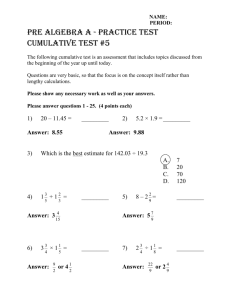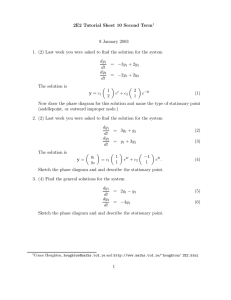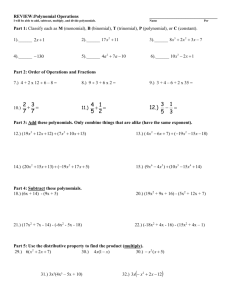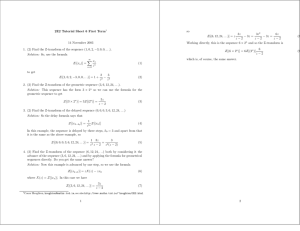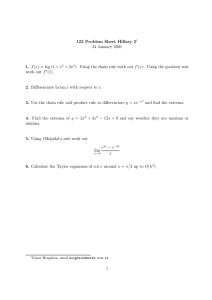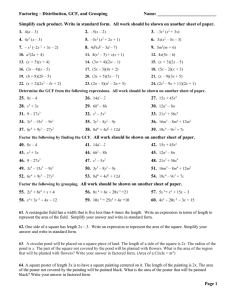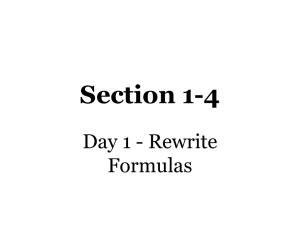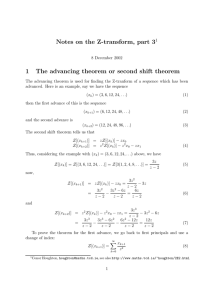2E2 Tutorial Sheet 7 First Term 21 November 2003
advertisement
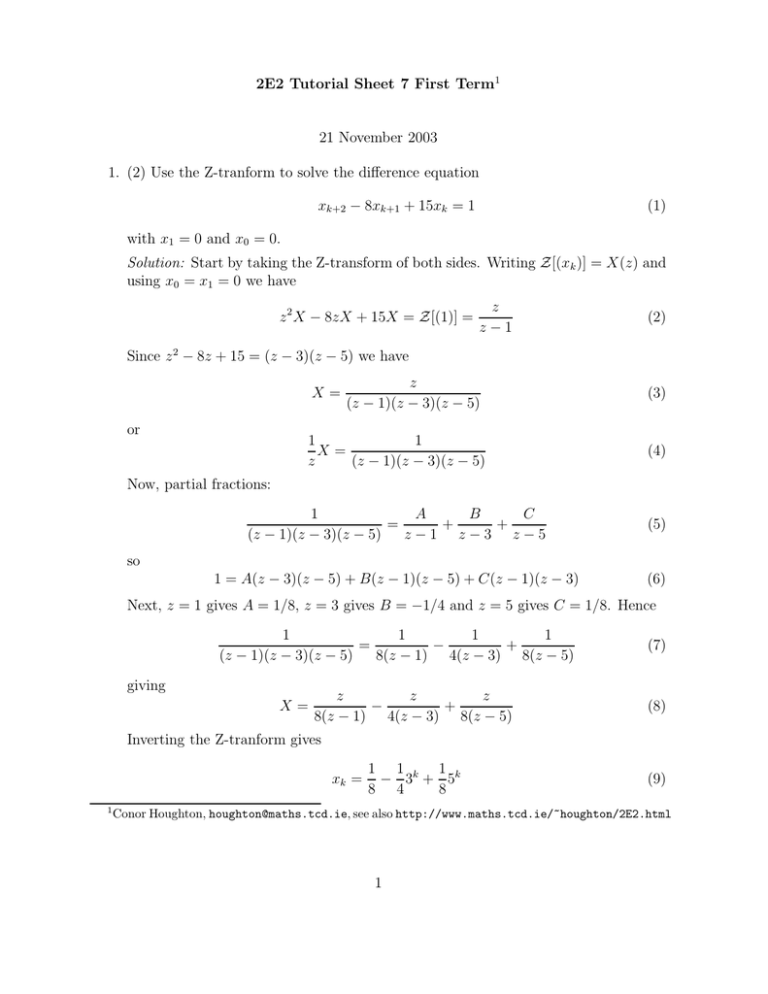
2E2 Tutorial Sheet 7 First Term1 21 November 2003 1. (2) Use the Z-tranform to solve the difference equation xk+2 − 8xk+1 + 15xk = 1 (1) with x1 = 0 and x0 = 0. Solution: Start by taking the Z-transform of both sides. Writing Z[(xk )] = X(z) and using x0 = x1 = 0 we have z 2 X − 8zX + 15X = Z[(1)] = z z−1 (2) Since z 2 − 8z + 15 = (z − 3)(z − 5) we have X= or z (z − 1)(z − 3)(z − 5) (3) 1 1 X= z (z − 1)(z − 3)(z − 5) (4) 1 A B C = + + (z − 1)(z − 3)(z − 5) z−1 z−3 z−5 (5) 1 = A(z − 3)(z − 5) + B(z − 1)(z − 5) + C(z − 1)(z − 3) (6) Now, partial fractions: so Next, z = 1 gives A = 1/8, z = 3 gives B = −1/4 and z = 5 gives C = 1/8. Hence 1 1 1 1 = − + (z − 1)(z − 3)(z − 5) 8(z − 1) 4(z − 3) 8(z − 5) giving X= z z z − + 8(z − 1) 4(z − 3) 8(z − 5) (7) (8) Inverting the Z-tranform gives xk = 1 1 1 k 1 k − 3 + 5 8 4 8 (9) Conor Houghton, houghton@maths.tcd.ie, see also http://www.maths.tcd.ie/~houghton/2E2.html 1 2. (2) Use the Z-tranform to solve the difference equation xk+2 − 8xk+1 + 15xk = 3k (10) with x1 = 0 and x0 = 0. Solution: Again, take the Z-tranform of both sides z 2 X − 8zX + 15X = Z[(3k )] = so z z−3 1 1 X= z (z − 3)2 (z − 5) (11) (12) We need to do a partial fraction expansion with a repeated root: 1 A B C = + + 2 2 (z − 3) (z − 5) (z − 3) z−3 z−5 (13) 1 = A(z − 5) + B(z − 3)(z − 5) + C(z − 3)2 (14) and so Choose z = 3 to find A = −1/2, z = 5 to get C = 1/4 and then substitute z = 0 to work out B by putting in the known values of A and C: 1 1 1 = − (−5) + 15B + 9 2 4 (15) Solving this gives B = −1/4. This means that X=− z z z + − 2 2(z − 3) 4(z − 3) 4(z − 5) (16) To invert we need to recall the table entry: Z[(kr k−1 )] = We get z (z − r)2 1 1 1 xk = − k3k−1 − 3k + 5k 2 4 4 (17) (18) 3. (2) Use the Z-tranform to solve the difference equation xk+2 − 8xk+1 + 15xk = δk (19) with x1 = 0 and x0 = 0. Remember δk is the unit pulse with δk = (1, 0, 0, 0, . . .). Solution: Take the Z-tranform of both sides, z 2 X − 8zX + 15X = Z[(δk )] = 1 2 (20) so X= 1 (z − 3)(z − 5) (21) Now, do partial fractions: 1 A B = + (z − 3)(z − 5) z−3 z−5 (22) 1 = A(z − 5) + B(z − 3) (23) and so Choose z = 3 for A = −1/2 and z = 5 for B = 1/2 and we obtain X=− 1 1 + 2(z − 3) 2(z − 5) (24) Now, the problem is that there are no z’s on top, if there were it would be easy: ∞ 1 1 k 1 k 1 (25) + =Z − 3 + 5 − 2(z − 3) 2(z − 5) 2 2 k=0 In other words 1 1 k 1 k X= Z − 3 + 5 z 2 2 (26) Now, this is what we get from the delay theorem, xk is the delay of the sequence by one step, so, 0 k=0 (27) xk = − 12 3k−1 + 12 5k−1 k > 0 4. (2) Use the Z-tranform to solve the difference equation xk+2 − 8xk+1 + 15xk = 0 (28) with x1 = 2 and x0 = 3. Solution: The complication this time is provided by the initial conditions, remember that Z[(xk+2 )] = z 2 X − z 2 x0 − zx1 and that Z[(xk+1 )] = zX − zx0 : z 2 X − 3z 2 − 2z − 8zX + 24z + 15X = 0 or X= 3z 2 − 22z (z − 3)(z − 5) (29) (30) It is convenient to bring one z over to the right: 1 3z − 22 X= z (z − 3)(z − 5) 3 (31) and now do partial fractions: 3z − 22 A B = + (z − 3)(z − 5) z−3 z−5 (32) 3z − 22 = A(z − 5) + B(z − 3) (33) so Hence z = 3 gives −13 = −2A or A = 13/2 and z = 5 gives −7 = 2B so B = −2/7, or, 7z 13z − (34) X= 2(z − 3) 2(z − 5) and hence xk = 13 k 7 k 3 − 5 2 2 4 (35)
